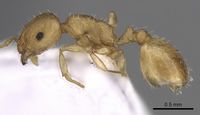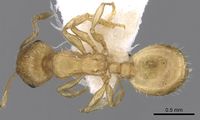Temnothorax subtilis
| Temnothorax subtilis | |
|---|---|

| |
| Scientific classification | |
| Kingdom: | Animalia |
| Phylum: | Arthropoda |
| Class: | Insecta |
| Order: | Hymenoptera |
| Family: | Formicidae |
| Subfamily: | Myrmicinae |
| Tribe: | Crematogastrini |
| Genus: | Temnothorax |
| Species group: | nylanderi |
| Species complex: | angustifrons |
| Species: | T. subtilis |
| Binomial name | |
| Temnothorax subtilis Csösz, Heinze & Mikó, 2015 | |
On Crete this is a mountain species with workers foraging in shady gorges or on rocks covered with moss (Salata, Borowiec & Trichas, 2018).
Identification
Csösz et al. (2015) - A member of the angustifrons species-complex. This species has the shortest propodeal spines of all species treated in this revision, and therefore can be separated from other species complexes by the non-overlapping SPST/CS ratio and its smooth and shiny head. Spine length ratio slightly overlaps with that of other species belonging to Temnothorax angustifrons complex yielding 94.5% success in distinguishing nest samples from T. angustifrons, Temnothorax lucidus, and Temnothorax similis. Simple FRS/SL ratios help separating this species from T. angustifrons.
A discriminant function with reduced character number (D4) arrives at 98.6% classification success between single individuals and complete success for nest sample means of T. subtilis and T. similis.
Though the SPST/CS ratio provides a fairly good quick key to separate nest samples of T. subtilis from those of T. lucidus, this character may broadly overlap in single individuals of these two species. In order to determine single workers with high success, a discriminant function with reduced character number (D4 = +0.0717_EL +0.0778_NOH +0.0404_SPST -0.0824_SPBA -10.321) yielding 98.6% classification success rate can be used.
Temnothorax subtilis can be easily separated from two additional species of the parvulus species-complex that occur in Crete, Temnothorax ariadnae and Temnothorax helenae, based on the shiny surface of the head dorsum. In exceptional cases or if dust cover obstructs a clear view of the surface sculpture, several ratios help to separate T. subtilis from T. ariadnae: it has a longer head (CL/CWb), larger eyes (EL/CS) and longer propodeal spines (SPST/CS), and a discriminant function with two characters (D2 = -0.0928_SPST +0.0215_ML -2.811) separates workers of T. subtilis from T. helenae if surface characteristics are not sufficient.
Keys including this Species
Distribution
Presently known from South Anatolia, Turkey, and Crete.
Latitudinal Distribution Pattern
Latitudinal Range: 41.63117° to 33.6757°.
| North Temperate |
North Subtropical |
Tropical | South Subtropical |
South Temperate |
- Source: AntMaps
Distribution based on Regional Taxon Lists
Palaearctic Region: Greece, Türkiye (type locality).
Distribution based on AntMaps
Distribution based on AntWeb specimens
Check data from AntWeb
Countries Occupied
| Number of countries occupied by this species based on AntWiki Regional Taxon Lists. In general, fewer countries occupied indicates a narrower range, while more countries indicates a more widespread species. |

|
Estimated Abundance
| Relative abundance based on number of AntMaps records per species (this species within the purple bar). Fewer records (to the left) indicates a less abundant/encountered species while more records (to the right) indicates more abundant/encountered species. |

|
Biology
Castes
Worker
Images from AntWeb
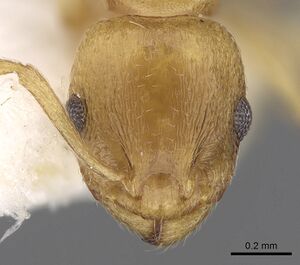  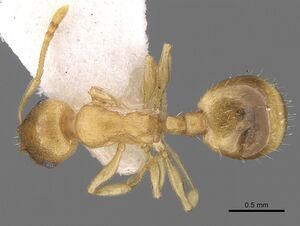 
| |
| Worker. Specimen code casent0906009. Photographer Estella Ortega, uploaded by California Academy of Sciences. | Owned by PCAS, Andreas Schulz Collection. |
   
| |
| Worker. Specimen code casent0906010. Photographer Estella Ortega, uploaded by California Academy of Sciences. | Owned by PCAS, Andreas Schulz Collection. |
  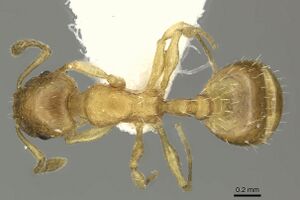 
| |
| Worker. Specimen code casent0906697. Photographer Estella Ortega, uploaded by California Academy of Sciences. | Owned by CAS, San Francisco, CA, USA. |
   
| |
| Holotype of Temnothorax subtilis. Worker. Specimen code casent0914635. Photographer Michele Esposito, uploaded by California Academy of Sciences. | Owned by HNHM, Budapest, Hungary. |
   
| |
| Worker. Specimen code casent0914687. Photographer Michele Esposito, uploaded by California Academy of Sciences. | Owned by HNHM, Budapest, Hungary. |
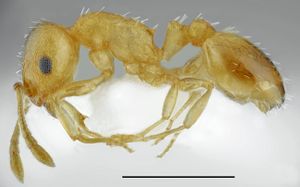
| |
| Specimen code casent0763867. . | |
Queen
Images from AntWeb
 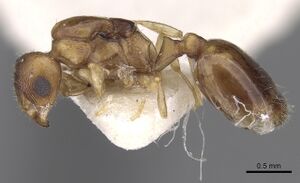  
| |
| Queen (alate/dealate). Specimen code casent0906008. Photographer Estella Ortega, uploaded by California Academy of Sciences. | Owned by PCAS, Andreas Schulz Collection. |
Nomenclature
The following information is derived from Barry Bolton's Online Catalogue of the Ants of the World.
- subtilis. Temnothorax subtilis Csösz, Heinze & Mikó, 2015: 26, figs. 12A-C (w.) TURKEY.
Unless otherwise noted the text for the remainder of this section is reported from the publication that includes the original description.
Description
Worker
Body color: yellow. Body color pattern: mesosoma, antenna and legs, waist and anterior region of 1st gastral tergite lighter than head dorsum and posterior region of gaster. Antenna color pattern: clava concolorous funicle. Absolute cephalic size: 499–628 μm (mean = 556, n = 55). Cephalic length vs. Maximum width of head capsule (CL/CWb): 1.135–1.238 (mean = 1.189). Postocular distance vs. cephalic length (PoOc/CL): 0.374–0.408 (mean = 0.388). Postocular sides of cranium contour frontal view orientation: converging posteriorly. Postocular sides of cranium contour frontal view shape: convex. Vertex contour line in frontal view shape: straight. Vertex sculpture: main sculpture dispersed forked costate, ground sculpture inconspicuous areolate. Genae contour from anterior view orientation: converging. Gena contour line in frontal view shape: feebly convex. Gena sculpture: rugoso-reticulate with feeble areolate ground sculpture. Median region of antennal rim vs. frontal carina in frontal view structure: not fully overlapped by frontal carina. Concentric carinae laterally surrounding antennal foramen count: present. Eye length vs. absolute cephalic size (EL/CS): 0.228–0.268 (mean = 0.249). Frontal carina distance vs. absolute cephalic size (FRS/CS): 0.335–0.375 (mean = 0.360). Longitudinal carinae on median region of frons count: present; absent. Smooth median region on frons count: present. Antennomere count: 12. Scape length vs. absolute cephalic size (SL/CS): 0.735–0.810 (mean = 0.782). Facial area of the scape absolute setal angle: 0–15°. External area of the scape absolute setal angle: 30°. Ground sculpture of submedian area of clypeus: smooth. Median carina of clypeus count: present. Lateral carinae of clypeus count: present. Median anatomical line of propodeal spine angle value to Weber length in lateral view: 47–52°. Spine length vs. absolute cephalic size (SPST/CS): 0.159–0.230 (mean = 0.192). Minimum spine distance vs. absolute cephalic size (SPBA/CS): 0.247–0.300 (mean = 0.272). Maximum spine distance vs. absolute cephalic size (SPWI/CS): 0.266–0.336 (mean = 0.282). Apical spine distance vs. absolute cephalic size (SPTI/CS): 0.256–0.322 (mean = 0.282). Maximum mesosoma width vs. absolute cephalic size (MW/CS): 0.592–0.648 (mean = 0.623). Metanotal depression count: present. Metanotal depression shape: deep. Dorsal region of mesosoma sculpture: fine areolate ground sculpture, superimposed by dispersed rugae. Lateral region of pronotum sculpture: inconspicuous areolate ground sculpture, main sculpture dispersed costate. Mesopleuron sculpture: fine areolate ground sculpture, superimposed by dispersed rugulae. Metapleuron sculpture: fine areolate ground sculpture, superimposed by dispersed rugulae. Frontal profile of petiolar node contour line in lateral view shape: concave. Dorsal profile of petiolar node contour line angle value to frontal profile of petiole contour line in lateral view: 95–105°. Anterodorsal rim of petiole count: absent medially. Dorsal region of petiole sculpture: ground sculpture areolate, main sculpture dispersed rugose; ground sculpture areolate, main sculpture absent. Dorso-caudal petiolar profile contour line in lateral view shape: straight; concave. Dorsal region of postpetiole sculpture: ground sculpture areolate, main sculpture dispersed rugose; ground sculpture areolate, main sculpture absent.
Type Material
Holotype worker labelled: TUR:431 Turkey, Taurus Mt., 5 km SW. Akseki, 37,0257 N, 31,7518 E, 950 mH, 02.11.2011, leg. A. Schulz, (Hungarian Natural History Museum, CASENT0914635), [TUR:Akseki-5SW-20111102-431].
Paratypes: TUR:431 Turkey, Taurus Mt., 5 km SW. Akseki, 37,0257 N, 31,7518 E, 950 mH, 02.11.2011, leg. A. Schulz, (1# HNHM), [TUR:Akseki-5SW-20111102-431]; TUR:430 Turkey, Taurus Mt., 5 km SW. Akseki, 37,0257 N, 31,7518 E, 950mH, 02.11.2011, leg. A. Schulz, (3## HNHM), [TUR:Akseki-5SW-20111102-430]; TUR:438 Turkey, Taurus Mt., 5 km SW. Akseki, 37,0257 N, 31,7518 E, 950 mH, 02.11.2011, leg. A. Schulz, (2## HNHM), [TUR:Akseki-5SW-20111102-438]; TUR:441 Turkey, Taurus Mt., 5 km SW. Akseki, 37,0257 N, 31,7518 E, 950 mH, 02.11.2011, leg. A. Schulz, (2## HNHM), [TUR:Akseki-5SW-20111102-441]; Turkey_08 Antalya, 2 km N. Imrasan Geçidi, 12 km N. Akseki, 37,0924 N, 31,803 E, 1400mH, 03.05.1997. leg. A. Schulz, K. Vock, M. Sanetra, (8## HNHM, 2## CAS CASENT0906012), [TUR:Imrasan-Geçidi-2N-19970503-117].
Etymology
The species epithet “subtilis” (Eng.: fine, thin, slender) refers to the fine, tiny appearance of this species.
References
- Csösz, S., Heinze, J. and Mikó, I. 2015. Taxonomic synopsis of the Ponto-Mediterranean ants of Temnothorax nylanderi species-group. PLoS ONE. 10(11):62pp. e0140000 (doi:10.1371/journal.pone.0140000).
- Kiran, K., Karaman, C. 2020. Additions to the ant fauna of Turkey (Hymenoptera, Formicidae). Zoosystema 42(18), 285-329 (doi:10.5252/zoosystema2020v42a18).
- Salata, S., Borowiec, L. 2019. Preliminary division of not socially parasitic Greek Temnothorax Mayr, 1861 (Hymenoptera, Formicidae) with a description of three new species. ZooKeys 877: 81-131 (doi:10.3897/zookeys.877.36320).
- Salata, S., Borowiec, L., Trichas, A. 2018. Taxonomic revision of the Cretan fauna of the genus Temnothorax Mayr, 1861 (Hymenoptera: Formicidae), with notes on the endemism of ant fauna of Crete. Annales Zoologici (Warsaw) 68(4): 769-808 (DOI 10.3161/00034541ANZ2018.68.4.004).
- Salata, S., Borowiec, L., Trichas, A. 2020. Review of ants (Hymenoptera: Formicidae) of Crete, with keys to species determination and zoogeographical remarks. Monographs of the Upper Silesian Museum No 12: 5–296 (doi:10.5281/ZENODO.3738001).
References based on Global Ant Biodiversity Informatics
- Borowiec L., and S. Salata. 2017. Ants of the Peloponnese, Greece (Hymenoptera: Formicidae). Polish Journal of Entomology 86: 193-236.
- Bracko G., K. Kiran, C. Karaman, S. Salata, and L. Borowiec. 2016. Survey of the ants (Hymenoptera: Formicidae) of the Greek Thrace. Biodiversity Data Journal 4: e7945. doi: 10.3897/BDJ.4.e7945
- Csősz S, Heinze J, and I. Mikó. 2015. Taxonomic synopsis of the Ponto-Mediterranean ants of Temnothorax nylanderi species-group. PLoS ONE 10(11): e0140000. doi:10.1371/journal.pone.0140000
- Salata S., L. Borowiec, and A.Trichas. 2018. Taxonomic Revision of the Cretan Fauna of the Genus Temnothorax Mayr, 1861 (Hymenoptera: Formicidae), with Notes on the Endemism of Ant Fauna of Crete. Annales Zoologici (Warsaw) 68(4): 769-808.
- Salata S., and L. Borowiec. 2018. Taxonomic and faunistic notes on Greek ants (Hymenoptera: Formicidae). Annals of the Upper Silesian Museum in Bytom Entomology 27: 1-51.
